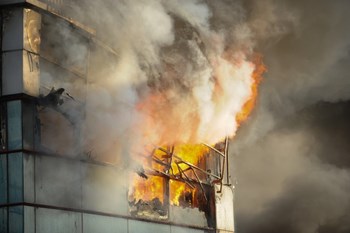
When a townhouse exploded on Manhattan's Upper East Side last summer, New Yorkers ran terror-stricken into the streets. As smoke billowed from the wreckage, no one knew what had caused the explosion, or how many people had been hurt. Just three months later, on October 11th, panicked residents were again evacuated when a small plane crashed into the 40th floor of the Belaire Condominium on 72nd Street. Smoke and flames consumed the brick wall where the plane lay lodged in one apartment owner's living room. A severed gas line caused a raging fire and sent a cascade of brick, mortar, glass and airplane parts crashing to the sidewalk below.
Amazingly, our firm manages both the Cumberland House, a 100-unit cooperative next door to the destroyed townhouse, and the Belaire Condominium. As chief executive officer and director of management at Gumley Haft, the two of us were among the first responders to both incidents, and present throughout the entire crisis management process. The lessons learned from these two tragic events can help co-op and condo boards and their managers be prepared to handle their own emergencies if and when they occur.
We suggest that boards work with their managers to establish a Disaster Management Plan, including a command center, rally points, evacuation plans and more in order to protect building residents and their property.
Explosion on 62nd Street
On July 10, 2006 at approximately 8:30 a.m., a townhouse on East 62nd Street exploded as a result of tampering—allegedly by the building's owner, Dr. Nicholas Bartha. The Cumberland House, a 15-story, 100-unit cooperative next door to the townhouse, took a beating from the explosion, with a rain of bricks from the townhouse and water from the New York City Fire Department (FDNY) pouring into the lower floors and underground parking garage on the east side of the building. When Gumley Haft received the call reporting the building explosion, we immediately went to the site. There is nothing quite as scary as seeing the building you live in—or manage—up in flames.
The townhouse was in a total collapse and engulfed in a fiery blaze. In a matter of minutes, representatives from the NYPD, FDNY, SWAT, FBI, Bureau of Alcohol Tobacco & Firearms (ATF), the Office of Emergency Management (OEM), the Red Cross and the mayor's office arrived at 62nd Street. This incident was initially considered a possible act of terrorism, so all federal, state and city law enforcement agencies were called in to determine what course of action to take.
When we arrived, the fire department and OEM were in the process of getting the immediate situation under control. Firefighters were attempting to extinguish the fire from the west and north sides of the building, shooting water through broken-out windows and using a ladder truck located on 62nd Street. The collapsed townhouse was reduced to a very large pile of burning rubble.
Plane Crash on 72nd Street
Three months later, a second crisis was upon us. On October 11, 2006 at approximately 3:30 pm, a small private aircraft slammed directly into the 40th floor of the Belaire Condominium. The plane entered through the living room window of an apartment and severed a gas line. While the propeller and engine remained in the apartment, the rest of the plane fell backwards, out of the building towards the street. The result was a raging fire, along with a cascade of brick, mortar and glass falling down from the building. Tragically, Cory Lidle, a New York Yankees pitcher, and his co-pilot perished in the crash.
The building staff began evacuating the property immediately while the site was being secured by emergency personnel. The FDNY began knocking down doors and breaking windows where necessary while watering down the building to quash the flames. Once the fire was under control, I, as Gumley Haft's CEO, along with the firm's management team, began to assess the immediate damage to the building and work up a game plan.
In this 48-story high-rise, there was now no gas, and limited use of the only running elevator, which was now being operated by the fire department. There was limited electricity, no house pumps, no water and no intercom. We also needed to secure the street to protect residents and the general public from the falling debris.
Emergency Procedures
The Command Center:The first thing you must do in such a crisis is establish a command center; a place where you, your managers, board members, superintendent, staff and emergency personnel can get together and plan out a course of action. At both disaster sites, we were fortunate that the OEM was on hand with their mobile command center unit, which is set up inside a bus near the site. If you do not get this kind of help, you need to create a command center yourself. It is from this central location that the situation is controlled and decisions are executed.
While you can never really be prepared for such an event, management and the board must take a leadership role and above all, remain calm. People are depending on these leaders and relying on the information they supply; their strength gives others comfort. All first responders and those in charge need to exercise extreme patience. Patience is a virtue and the feelings and emotions of the people affected by the crisis must be considered. For many, this is the loss of their home and their personal belongings. For others, it could be far worse—they or one of their loved ones may have been injured, lost or even killed.
Evacuation and Re-Entry: It is important to have a handle on the demographics of the building. The management team must establish who was in the building at the time of the disaster and whether they have been evacuated. Be sure to have all of the following demographic information on hand: names, phone numbers, apartment numbers of all residents; names of any elderly or infirm residents in the building who might need help getting out; a list of all children and pets; a list of any resident who works from home. This information should be stored both on the premises and at the manager's office in case there is damage to the on-site office.
When the FDNY evacuates a building, everyone is ordered to leave immediately. No one may pack a bag, change clothes, get medicine or gather valuables or important documents. At one building, residents were wandering in the street in their bathrobes, many with no identification on them. It is imperative that someone at the command center—doorpersons, building staff, the resident manager or someone affiliated with the building directly—know each and every person in the building by face and name, and knows a little bit about them. That way when residents ask to get back into their apartments, their identity can be confirmed. Once identity has been established and the property secured, an orderly system of escorting individuals back into the building can be implemented.
Rally Points: The most efficient way to disseminate information to building residents is to establish "rally points." Rally points are places off-premises, but close to the building, where residents are told to gather in the event of an emergency. This is a place to relax in safety, come to grips with what has happened and plan out a course of action. Most importantly, rally points are places where you can give out information and let people know what is going on. At both of our disasters, fear of the unknown was rampant: What had happened? Was it terrorism? Is the building going to be all right? Is my pet OK? We used our rally points to get our residents the information they needed. A rally point could be a restaurant, a nearby YMCA or library. A rally point should be chosen in advance, so that as soon as an incident occurs, people know where to go, or can be told where to go.
Back Up Data: At The Cumberland House, we had another interesting wrinkle: the explosion and fire had entirely engulfed the resident manager's apartment. This was bad, but even worse was that his computer was destroyed, which meant he could no longer access vital information about all the residents in the building. Fortunately, our sophisticated computer system, which is used in all of our buildings, maintains a matching data file back in our main office. When we learned that the on-site computer had been destroyed, it was a simple matter to have the information rushed to the command center from our office. In addition, we maintain a complete backup of every building's information off premises, in the event that a disaster strikes in our own office.
Epilogue
We are now well into the rebuilding of both properties and have implemented strategies for each of our buildings and our office in the event of another disaster, however remote it may seem. Command centers, rally points, backup data, including up-to-date building resident and owner lists complete with phone numbers and emergency contacts, have been established and we keep our resident managers, superintendents and building staff well briefed on what to do should an emergency befall their building. When disaster strikes, our title of property manager pales in comparison to the role we must play. We encourage all of you to learn from our experiences and prepare yourself for the unimaginable.
Dan Wollman is chief executive officer of Gumley Haft and executive vice president of the New York Association of Realty Managers (NYARM). Harry Smith is director of management at Gumley Haft.
Here are some of the major points every property manager and cooperative and condominium board should consider in preparing for a building-wide emergency.
Command Center: This is the information hub for your property. An off-premises site is preferred, but someplace close to the property is needed. This is where the manager, board, superintendent, building staff and emergency personnel can meet and plan out their course of action.
Rally Points: Locations near the building, established in advance, where residents can be instructed to go for safety, and to receive information. A primary and secondary Rally Point should be chosen in advance, in case one is unusable as a result of the emergency. Restaurants, libraries and YMCAs are excellent choices for Rally Points.
Have a Remediation and Repair Team in Place: This is where organization and advance planning come into play. We recommend that each building have a set of professionals who regularly work at the property. Plumbers, electricians, boiler, elevator and window repair people who are familiar with the intricacies of the building, should be used. Avoid bringing in a contractor who has never set foot on the property.
Evacuation: Much like in office buildings, it is advisable to have one person on each floor act as a "Point" person; someone who knows who lives on that floor, any resident who is infirm, who has children and pets, etc. This can help the evacuation and re-entry process immeasurably.
Data and Back-Up Information: Be sure to have a list of owners and residents both on the premises and in the management company's office at all times, so that if an emergency does occur, the list is available immediately. It is very important to know who has been evacuated, who may be unaccounted for, and to be able to identify people who are permitted to re-enter the building.
Continuing Education: Lastly, we encourage our managers to take full advantage of educational opportunities like those sponsored by the New York Association of Realty Managers (NYARM). They offer many courses and seminars taught by experienced professionals for managers, resident managers and superintendents. We recently gave a talk on these disasters and how we handled the fluid situations we found ourselves facing.






Leave a Comment